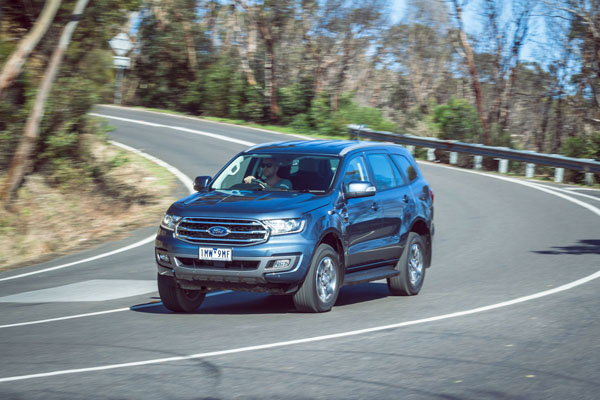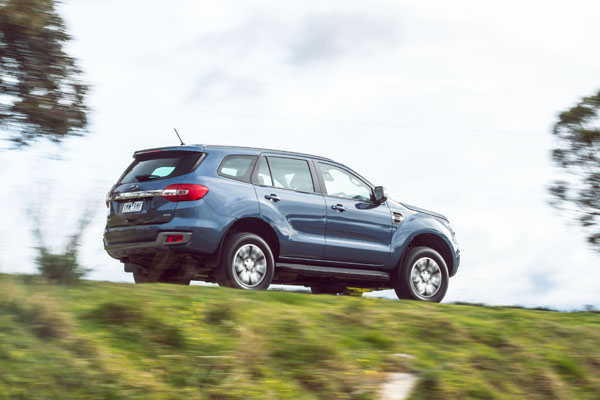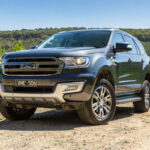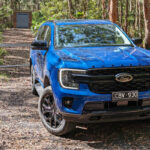
Everest, the highest mountain on Earth, is subject to constant change at the hands of the forces of nature. Similarly, the eponymous Ford sports utility vehicle has had several updates since its introduction to Australia in 2016.
Everything about the sports utility vehicle – radiator grille, rear end, guards and wheels, even badging – was designed to make the SUV appear as big as possible.
At close to five metres long, more than two metres wide and almost two metres tall, the dimensions also made for a spacious and versatile cabin capable of carrying up to seven occupants and gear in relative comfort.
The seven-seat 4WD wagon came in three variants – Ambiente, Trend and Titanium – priced from $54,990, plus on-road costs, topping out with the Titanium at $22,000 later. The mid-range Trend cost $60,990.
The MY19 upgrade took on a new-generation powertrain, which included a bi-turbo, four-cylinder diesel engine, mated with a 10-speed automatic transmission; and a raft of the latest safety systems and convenience features, as well as a five-year unlimited kilometre warranty and further service benefits.
The Trend bi-turbo enjoyed only a small rise in pricing over the preceding single-turbo model. Now, in front of a completely redesign for 2022, the Everest, sports a new grille and premium technology, with the Trend 2.0-litre four-wheel drive, on test, leading the way at $62,390, plus on-roads.
STYLING
Ford Everest’s rugged appearance have all variants holding ground with any rival. The Trend scores features such as 18-inch alloy wheels and running boards, while the square shaped rear of many traditional SUVs is replaced by Everest’s sculpted tail lamps, with integrated LED lighting.
Trend is further switched on with HID headlamps with auto levelling function, LED day-time running lights, plus hands-free power lift tailgate.

INTERIOR
The cabin is a genuine seven-seater. Flexible second-row seats have 60 / 40 split, and power-fold third-row seats with 50 / 50 split, can be folded flat, providing 2010 litres of versatile cargo space with a class-leading payload of up to 750 kg.
Joining the features for Trend are leather accented seat trim (third-row occupants miss out), leather trimmed gear lever and eight-way power driver’s seat with manual lumbar support.
Boot space in the seven-seater is a claimed 249 litres with all seats up and in use; 876 litres with the third-row seats down; and 1796 litres with the second row down.
INFOTAINMENT
Standard Trend features include Ford’s SYNC 3 multimedia system with Apple CarPlay and Android Auto, an 8.0-inch full-colour touchscreen and 10-speaker audio system,
The high resolution 8-inch colour touchscreen in the Interior Command Centre is one of the easiest on the market to view and operate. The up-to-date design of the instrumentation cluster, which incorporates dual 4-inch colour screens, is a competent companion.
An AM/FM/CD audio system with DAB+ digital and 10 speakers is augmented by AUX/iPod/ USB/SD card input ports. Voice control works with simple commands for many vehicle and convenience systems and emergency assistance connects drivers with emergency responders in a serious collision.
ENGINES / TRANSMISSIONS
The bi-turbo diesel engine in the Everest Trend is puts out maximum power of 157 kW at 3750 rpm and top torque of 500 Nm between 1750 and 2500 revolutions.
The package adds a ten-speed automatic transmission and has the option of rear or four-wheel drive.
SAFETY
With a five-star safety rating the Trend pre-collision assist and pedestrian detection with the autonomous emergency braking system and traffic sign recognition.
There are seven airbags, including driver’s knee airbag. Dynamic stability control with roll stability control, ABS anti-skid brakes with electronic brake force distribution, traction control and emergency brake assist are constantly active when on the move.
Parking is made easy with the use of a rear-view camera, plus audible sensors front and rear.

DRIVING
The bi-turbo diesel motor, which pumps out 157 kW of power and a fat 500 Nm of torque (10 kW and 30 Nm more than its predecessor), pushing the big SUV to new heights.
Overtaking on the highway, for example, is only a matter of easing the accelerator pedal forward and the power needed is presented smoothly, making the sometimes ticklish manoeuvre a breeze.
Gone is the fiddly old-style ignition key; replaced by push-button engine start / stop and new gear shifter.
Fuel consumption topped 12 litres per 100 kilometres in mixed traffic conditions and 6.5 litres per 100 kilometres on the open road.
Unique five-spoke 18-inch alloy wheels and sleek side panels emphasise on-road character, while generous ground clearance (225 mm) and 800 mm wading depth get the Everest ready for anything off the bitumen.
Shortcomings – short being the operative word – rest with the rear seats, the third row, when in use, offers little head room for an adult making more than short journeys a chore. Getting in and out is quite a step up too.
However, occupants have the advantage of dual zone climate control and more than 30 stowage spots totalling 48 litres (the glovebox can take a 16-inch laptop), while sound insulating materials and active noise cancellation technology make for a quiet cabin.
SUMMARY
Despite no longer being an Australian vehicle manufacturer, Ford maintains a large cohort of designers and engineers Downunder This goes a long way to giving Aussies what they want in the Everest range, a fact destined to be emphasised with the release of an all-new model next year.
AT A GLANCE
MODEL LINE-UP
Ambiente 3.2 RWD: $50,090
Ambiente 3.2 4WD: $55,090
Trend 2.0 RWD: $57,090
Trend 3.2 4WD: $60,890
Trend 2.0 4WD: $62,390
BaseCamp 3.2 4WD: $63,090
BaseCamp 2.0 4WD: $64,590
Sport 2.0 RWD: $60,090
Sport 3.2 4WD: $62,890
Sport 2.0 4WD: $64,390
Titanium 2.0 4WD: $73,190
Note: These prices do not include government or dealer delivery charges. Contact your local Ford dealer for drive-away prices.
SPECIFICATIONS (Ford Everest Trend 2.0L turbodiesel, 4-cylinder, 10-speed automatic, AWD)
ENGINE:
Capacity: 1.996 litres
Configuration: Four cylinders in line
Maximum Power: 157 kW @ 3750 rpm
Maximum Torque: 500 Nm @ 1750-2500 rpm
Fuel Type: Diesel
Combined Fuel Cycle (ADR 81/02): 7.0 L/100km
DRIVELINE: Ten-speed automatic, all-wheel drive
DIMENSIONS, WEIGHT AND CAPACITIES:
Length: 4892 mm
Wheelbase: 2850 mm
Width: 1860 mm
Height: 1837 mm
Turning Circle: 11.7 metres
Kerb Mass: 2413 kg
Fuel Tank Capacity: 80 litres
BRAKES:
Front: Ventilated disc
Rear: Disc
STANDARD WARRANTY:
Five years / unlimited kilometres
RATINGS:
Looks: 7/10
Performance: 8/10
Safety: 6/10
Thirst: 6/10
Practicality: 7/10
Comfort: 5/10
Tech: 5/10
Value: 6/10
Overall: 6.3/10










